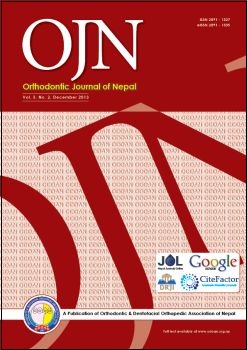Palatal Rugae Pattern in Nepalese Subjects
DOI:
https://doi.org/10.3126/ojn.v3i2.10076Keywords:
forensic odontology, palatal rugae, patternAbstract
Objective: To determine the number and pattern of palatal rugae in Nepalese subjects and to find the association of gender with the number and pattern of palatal rugae.
Materials & Method: 200 Nepalese subjects comprising of 100 male and 100 female were randomly selected and their maxillary casts were examined for the palatal rugae length applying the classification proposed by Thomas and Kotze and palatal rugae pattern was recorded using the classification given by Kapali. Statistical analysis using Student t-test was applied for comparing the number of palatal rugae between right and left sides. Chi square test was used to find the association between gender and number of rugae as well as the pattern.
Result: The study demonstrated that the mean number of primary palatal rugae on left side was predominant, similarly wavy pattern was the most predominant in Nepalese subjects. No statistical significant difference was noticed in the palatal rugae number and pattern between the gender groups.
Conclusion: The study found predominant palatal form in Nepalese subjects which might have superior effectiveness in population differentiation and may be used as an effective tool in forensic odontology identification.
Downloads
Downloads
Published
How to Cite
Issue
Section
License
Copyright © held by Orthodontic & Dentofacial Orthopedic Association of Nepal
- Copyright on any research article is transferred in full to the Orthodontic & Dentofacial Orthopedic Association of Nepal upon publication in the journal. The copyright transfer includes the right to reproduce and distribute the article in any form of reproduction (printing, electronic media or any other form).
- Articles in the Orthodontic Journal of Nepal are Open Access articles published under the Creative Commons CC BY License (https://creativecommons.org/licenses/by/4.0/)
- This license permits use, distribution and reproduction in any medium, provided the original work is properly cited.




